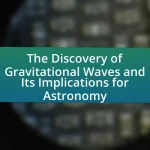The article focuses on the impact of stellar discoveries on our understanding of the universe, highlighting the identification and analysis of celestial bodies such as stars, planets, and galaxies. It discusses the evolution of stellar discoveries from ancient observations to modern technological advancements, emphasizing key milestones and the significance of discoveries like exoplanets and supernovae. The article also explores how these findings contribute to cosmology, inform theories about the universe’s origin, and enhance our understanding of dark matter and dark energy. Additionally, it addresses the practical applications of stellar research and the role of citizen scientists in advancing astronomical knowledge.

What are Stellar Discoveries and Their Significance?
Stellar discoveries refer to the identification and analysis of celestial bodies, such as stars, planets, and galaxies, which enhance our understanding of the universe. These discoveries are significant because they provide insights into the formation, evolution, and behavior of cosmic entities, thereby informing theories about the origins of the universe and the fundamental laws of physics. For instance, the discovery of exoplanets has expanded our knowledge of planetary systems beyond our own, while observations of supernovae have contributed to the understanding of cosmic expansion and dark energy. Such findings are crucial for advancing astrophysics and refining models of the universe’s structure and dynamics.
How have stellar discoveries evolved over time?
Stellar discoveries have evolved from ancient observations of stars to advanced astrophysical research using modern technology. Initially, civilizations relied on naked-eye observations to categorize stars and constellations, leading to early astronomical models. The invention of the telescope in the 17th century allowed astronomers like Galileo to observe celestial bodies in greater detail, revealing moons of Jupiter and the phases of Venus, which challenged existing geocentric models.
In the 20th century, the development of spectroscopy enabled scientists to analyze the composition and movement of stars, leading to the understanding of stellar evolution and the life cycle of stars. The discovery of neutron stars and black holes further expanded knowledge about extreme states of matter and gravitational phenomena.
Recent advancements in space telescopes, such as the Hubble Space Telescope, have provided unprecedented views of distant galaxies and stellar formations, enhancing our understanding of the universe’s structure and expansion. These discoveries have fundamentally shifted our comprehension of cosmic phenomena, illustrating the dynamic nature of stellar research and its impact on our understanding of the universe.
What key milestones mark the history of stellar discoveries?
Key milestones in the history of stellar discoveries include the identification of the first stars by ancient astronomers, the invention of the telescope in the early 17th century, which allowed for the observation of distant stars, and the development of spectroscopy in the 19th century, enabling the analysis of stellar compositions. The discovery of the Hertzsprung-Russell diagram in the early 20th century provided a framework for understanding stellar evolution, while the detection of exoplanets in the late 20th century expanded our knowledge of star systems. Each of these milestones significantly advanced our understanding of the universe and the role of stars within it.
How have technological advancements influenced stellar discoveries?
Technological advancements have significantly enhanced stellar discoveries by providing more precise instruments and methods for observation. For instance, the development of powerful telescopes, such as the Hubble Space Telescope, has allowed astronomers to capture high-resolution images of distant galaxies and stars, revealing details previously obscured. Additionally, advancements in spectroscopy have enabled scientists to analyze the composition and movement of celestial bodies, leading to the identification of exoplanets and the understanding of stellar evolution. These innovations have resulted in a deeper comprehension of the universe, as evidenced by the discovery of over 5,000 exoplanets since the 1990s, fundamentally altering our knowledge of planetary systems beyond our own.
Why are stellar discoveries crucial for understanding the universe?
Stellar discoveries are crucial for understanding the universe because they provide insights into the formation, evolution, and composition of celestial bodies and the cosmos as a whole. For instance, the discovery of exoplanets has expanded our knowledge of planetary systems beyond our own, revealing diverse environments that could harbor life. Additionally, observations of supernovae have helped astronomers measure cosmic distances, leading to the understanding of the universe’s expansion rate. These findings are supported by data from missions like the Kepler Space Telescope, which identified thousands of exoplanets, and the Hubble Space Telescope, which has observed supernovae to refine the Hubble constant.
What fundamental questions do stellar discoveries help answer?
Stellar discoveries help answer fundamental questions about the formation and evolution of the universe, the lifecycle of stars, and the nature of cosmic phenomena. For instance, the observation of supernovae provides insights into the processes that lead to star death and the synthesis of heavy elements, which are crucial for understanding the chemical evolution of galaxies. Additionally, discoveries of exoplanets around stars enhance our knowledge of planetary formation and the potential for life beyond Earth. These findings are supported by data from telescopes like Hubble and missions such as Kepler, which have documented various stellar phenomena and their implications for cosmic understanding.
How do stellar discoveries contribute to our knowledge of cosmic phenomena?
Stellar discoveries enhance our understanding of cosmic phenomena by providing insights into the life cycles of stars, the formation of galaxies, and the nature of dark matter and dark energy. For instance, the observation of supernovae has revealed critical information about the expansion rate of the universe, leading to the discovery of dark energy, which constitutes approximately 68% of the universe. Additionally, the study of exoplanets around various stars has expanded our knowledge of planetary systems and the potential for life beyond Earth. These discoveries are supported by data from telescopes like the Hubble Space Telescope and missions such as Kepler, which have cataloged thousands of stars and their properties, thereby enriching our comprehension of the universe’s structure and evolution.

What are the Major Types of Stellar Discoveries?
The major types of stellar discoveries include the identification of new stars, the classification of stellar types, the discovery of exoplanets, and the observation of stellar phenomena such as supernovae and neutron stars. New stars are often discovered through surveys and telescopic observations, while classification involves categorizing stars based on their spectral characteristics, such as temperature and luminosity. The discovery of exoplanets, which are planets orbiting stars outside our solar system, has expanded our understanding of planetary systems and their formation. Observations of stellar phenomena, like supernovae, provide insights into stellar evolution and the life cycles of stars. These discoveries collectively enhance our comprehension of the universe’s structure and dynamics.
What are the different categories of stellar discoveries?
The different categories of stellar discoveries include the identification of new star types, the discovery of exoplanets, the observation of stellar evolution, and the detection of stellar remnants. Each category contributes to our understanding of the universe; for instance, the identification of new star types, such as red dwarfs and blue giants, enhances our knowledge of stellar classification and formation processes. The discovery of exoplanets, particularly those in habitable zones, expands our understanding of planetary systems and the potential for life beyond Earth. Observations of stellar evolution, including supernovae and the life cycles of stars, provide insights into the chemical enrichment of the universe. Lastly, the detection of stellar remnants, such as black holes and neutron stars, informs theories about gravity and the fundamental nature of matter.
How do we classify stars based on their characteristics?
Stars are classified based on their characteristics such as temperature, luminosity, size, and spectral type. The main classification system is the Hertzsprung-Russell diagram, which categorizes stars into different groups, including main sequence stars, giants, supergiants, and white dwarfs, based on their position in relation to their brightness and temperature. For example, main sequence stars, like our Sun, fuse hydrogen into helium and are found along a diagonal band on the diagram, while red giants are located in the upper right, indicating higher luminosity and cooler temperatures. This classification is supported by observational data from telescopes and spectroscopic analysis, which provide insights into the physical properties of stars, confirming their placement in the classification system.
What role do exoplanets play in stellar discoveries?
Exoplanets play a crucial role in stellar discoveries by providing insights into the formation and evolution of stars and planetary systems. The detection of exoplanets around various types of stars allows astronomers to study the conditions that lead to planet formation, revealing the diversity of planetary systems and their potential habitability. For instance, the Kepler Space Telescope has identified thousands of exoplanets, significantly enhancing our understanding of how stars and their planets interact. This data supports theories of stellar evolution and helps refine models of how stars influence the development of their surrounding environments.
How do stellar explosions and remnants enhance our understanding?
Stellar explosions and their remnants enhance our understanding of the universe by providing critical insights into the life cycles of stars, the formation of elements, and the dynamics of cosmic events. These phenomena, such as supernovae, are key to understanding nucleosynthesis, as they produce heavy elements like gold and uranium, which are essential for the chemical evolution of galaxies. For instance, the observation of supernova remnants allows astronomers to study the distribution of these elements in the interstellar medium, thereby revealing the processes that shape galactic structures. Additionally, the study of neutron stars and black holes formed from stellar remnants offers insights into extreme physics, including gravitational waves and the behavior of matter under intense conditions. This knowledge is supported by data from telescopes like Hubble and observatories that detect electromagnetic radiation across various wavelengths, confirming the role of stellar explosions in enriching our cosmic environment.
What insights do supernovae provide about the life cycle of stars?
Supernovae provide critical insights into the life cycle of stars by marking the explosive end stages of massive stars and revealing the processes of stellar evolution. These events illustrate how stars exhaust their nuclear fuel, leading to core collapse and subsequent explosion, which contributes to the synthesis of heavy elements. For instance, supernovae are responsible for dispersing elements like iron and nickel into the interstellar medium, which are essential for the formation of new stars and planets. Observations of supernova remnants also allow astronomers to study the progenitor stars’ mass and composition, enhancing our understanding of stellar lifespans and the conditions necessary for different types of supernovae, such as Type Ia and Type II. This knowledge is supported by data from various supernova observations, including the 1987A supernova, which provided valuable information about the processes occurring during stellar death and the subsequent impact on galactic evolution.
How do black holes challenge our understanding of physics?
Black holes challenge our understanding of physics by presenting contradictions between general relativity and quantum mechanics. General relativity describes gravity as the curvature of spacetime around massive objects, predicting that black holes possess singularities where density becomes infinite and the laws of physics as we know them break down. Conversely, quantum mechanics introduces principles such as uncertainty and wave-particle duality, which do not align with the deterministic nature of general relativity in extreme conditions like those found in black holes. This conflict raises fundamental questions about the nature of reality, leading to ongoing research in theoretical physics, including attempts to formulate a theory of quantum gravity.

What Impact Do Stellar Discoveries Have on Cosmology?
Stellar discoveries significantly enhance cosmology by providing critical insights into the formation and evolution of the universe. For instance, the identification of various types of stars, such as red giants and supernovae, allows astronomers to understand stellar lifecycles and the processes that lead to the creation of heavy elements, which are essential for planet formation. Furthermore, discoveries like the cosmic microwave background radiation, linked to stellar phenomena, offer evidence for the Big Bang theory, solidifying our understanding of the universe’s origins. These findings collectively contribute to refining models of cosmic expansion and the overall structure of the universe, demonstrating the profound impact of stellar research on cosmological theories.
How do stellar discoveries influence theories of the universe’s origin?
Stellar discoveries significantly influence theories of the universe’s origin by providing empirical data that either supports or challenges existing models. For instance, the discovery of exoplanets and their diverse characteristics has prompted revisions to the nebular hypothesis, which describes the formation of solar systems. Additionally, observations of cosmic microwave background radiation have reinforced the Big Bang theory, illustrating how stellar phenomena can validate or refine our understanding of cosmic evolution. These discoveries lead to new insights about stellar life cycles, nucleosynthesis, and the distribution of elements, which are crucial for understanding the universe’s formation and development.
What evidence supports the Big Bang theory through stellar observations?
The evidence supporting the Big Bang theory through stellar observations includes the discovery of cosmic microwave background radiation and the redshift of distant galaxies. Cosmic microwave background radiation, detected in 1965 by Arno Penzias and Robert Wilson, is a remnant heat signature from the early universe, consistent with predictions of the Big Bang model. Additionally, the observation of redshift in the light from distant galaxies, as described by Edwin Hubble in the 1920s, indicates that these galaxies are moving away from us, suggesting that the universe is expanding, which aligns with the Big Bang theory’s premise of an expanding universe from an initial singularity.
How do stellar discoveries inform our understanding of dark matter and dark energy?
Stellar discoveries enhance our understanding of dark matter and dark energy by providing critical insights into the behavior and distribution of matter in the universe. For instance, observations of stellar motions in galaxies reveal that visible matter alone cannot account for the gravitational forces at play, indicating the presence of dark matter. The rotation curves of galaxies, which show that stars at the edges rotate faster than expected, support this conclusion, as they suggest an unseen mass that exerts gravitational influence.
Additionally, studies of supernovae and the cosmic microwave background radiation have led to the conclusion that dark energy is driving the accelerated expansion of the universe. The discovery of Type Ia supernovae as standard candles allowed astronomers to measure distances in the universe accurately, revealing that the expansion rate is increasing, which is attributed to dark energy. These stellar observations collectively provide a framework for understanding the unseen components of the universe, confirming their existence and influencing cosmological models.
What are the implications of stellar discoveries for future research?
Stellar discoveries significantly enhance future research by providing new insights into the formation and evolution of stars, which in turn informs our understanding of galaxy formation and the overall structure of the universe. For instance, the discovery of exoplanets around various star types has opened avenues for astrobiology, prompting research into the conditions necessary for life beyond Earth. Additionally, findings related to stellar nucleosynthesis reveal how elements are formed in stars, impacting fields such as cosmology and material science. The detection of gravitational waves from stellar events has also revolutionized astrophysics, allowing researchers to study phenomena that were previously undetectable. These discoveries collectively drive advancements in technology, observational techniques, and theoretical models, shaping the future trajectory of astronomical research.
How can upcoming missions expand our knowledge of the universe?
Upcoming missions can expand our knowledge of the universe by enabling the exploration of celestial bodies, gathering data on their composition, and enhancing our understanding of cosmic phenomena. For instance, missions like the James Webb Space Telescope are designed to observe distant galaxies, providing insights into the formation of stars and planets. Additionally, the European Space Agency’s Hera mission aims to study asteroids, which can reveal information about the early solar system and the building blocks of life. These missions utilize advanced technology to collect precise measurements, allowing scientists to test existing theories and develop new models of the universe’s evolution.
What role do citizen scientists play in stellar discovery initiatives?
Citizen scientists play a crucial role in stellar discovery initiatives by contributing data analysis, observations, and research efforts that enhance our understanding of celestial phenomena. Their involvement allows for the processing of vast amounts of astronomical data, which professional astronomers may not have the capacity to analyze alone. For instance, projects like Galaxy Zoo have engaged thousands of volunteers to classify galaxies, leading to significant findings in galaxy morphology and evolution. This collaborative effort not only accelerates research but also democratizes science, enabling non-professionals to contribute meaningfully to discoveries that shape our comprehension of the universe.
What practical applications arise from our understanding of stellar discoveries?
Understanding stellar discoveries leads to practical applications in various fields, including navigation, climate science, and materials research. For instance, advancements in stellar observation techniques enhance our ability to navigate using celestial bodies, which is crucial for space exploration and satellite positioning. Additionally, studying stellar phenomena contributes to climate models by providing insights into solar activity and its effects on Earth’s climate. Furthermore, the knowledge gained from stellar compositions aids in the development of new materials, as researchers can replicate conditions found in stars to create innovative substances. These applications demonstrate the tangible benefits of our understanding of the universe through stellar discoveries.
How can knowledge of stellar phenomena benefit technology and innovation?
Knowledge of stellar phenomena can significantly benefit technology and innovation by driving advancements in materials science, telecommunications, and energy production. For instance, research into stellar fusion processes has led to the development of nuclear fusion technology, which promises a cleaner and virtually limitless energy source. Additionally, understanding stellar radiation has improved satellite technology, enhancing global communication systems. The study of exoplanets and their atmospheres has also spurred innovations in data analysis and imaging technologies, which are applicable in various fields, including medicine and environmental monitoring. These advancements demonstrate how insights gained from stellar phenomena directly translate into practical technological applications, fostering innovation across multiple sectors.
What lessons can we learn from stellar discoveries for Earth-based challenges?
Stellar discoveries teach us the importance of collaboration and innovation in addressing Earth-based challenges. For instance, the collaborative efforts in astrophysics, such as the Event Horizon Telescope project that captured the first image of a black hole, demonstrate how interdisciplinary teamwork can lead to groundbreaking solutions. This model can be applied to global issues like climate change, where diverse expertise is essential for developing effective strategies. Additionally, the technological advancements driven by space exploration, such as satellite technology for monitoring environmental changes, provide practical tools for tackling terrestrial problems. These examples illustrate that the methodologies and technologies developed through stellar research can be directly adapted to improve our responses to challenges on Earth.




